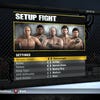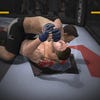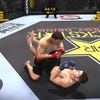EA Sports MMA
Clinch of salt.
As it increases in popularity, the world of Mixed Martial Arts is becoming ever more competitive as the best of the best get better by eliminating the weaknesses in their comprehensive fighting styles. With many epic battles to its name, 2010 has already tested some of the sports' greatest champions.
Brock Lesnar's title defence against Shane Carwin and Anderson Silva's gruelling match against Chael Sonnen both saw a bruised champion snatch a submission victory from the jaws of defeat. But while the real-life competition has been consistently brutal, MMA videogames have been dominated by the unchallenged success of UFC Undisputed – until now.
EA Sports MMA steps into the ring this week to see if it has the mettle to topple the champion. But with THQ and Yuke's game having exclusivity with the UFC's armoury of muscle-bound sluggers, how has EA Tiburon come up with a competitive roster?Fortunately, the UFC isn't the only promoter with a penchant for bloody bouts and octagonal cages; EA has teamed up with one of Dana White's biggest competitors, Strikeforce.
We see a virtual Randy Couture wailing on a floored Tim Sylvia as MMA's intro kicks off to a Linkin Park beat. This is then followed by an explosive roll call of Strikeforce's biggest names, including Fabricio Werdum, Fedor Emelianenko and Cung Le. Fedor presides over the main menu, his eyes nonchalantly following whichever game mode you're highlighting. After making him nod like a Churchill pup for about 10 seconds, you may decide it's best not to piss off one of the toughest men on the planet and venture into Fight Now mode.
The fight options range from choosing a rule set which may or may not allow ground knees and elbows to picking from 13 different cages and boxing rings. The size of the roster is impressive, with around 60 fighters including familiar faces like Dan Henderson and current Heavyweight champion Alistair Overeem, who, despite being born in London, avoids adding to our surplus of national pride by being Dutch.
Once the long-winded introductions are out of the way, it's time to start dancing in the octagon. As opposed to Undisputed's fairly technical control scheme, MMA is trying for something more intuitive. It borrows the Total Strike Control system from Fight Night which works by flicking the right analogue stick in different motions, allowing you to string together jabs, hooks, uppercuts and backfists.
Far from being limited to your fists, MMA mixes things up substantially with kick, low and fake modifiers which cater for flying footwork, body strikes and deceptive fakeouts. Defensive manoeuvres, meanwhile, are mapped to the block button and can be modified with the analogue sticks, allowing you to absorb heavy blows, duck away from predictable haymakers and, if you're really good, parry them mid-air to open up counter opportunities.
In a toe-to-toe stand-off, MMA's striking repertoire isn't as extensive as Undisputed's, and in terms of stringing together precise combinations, let's just say that the inclusion of a button-based Classic configuration was a wise decision. But its style of combat is easier to comprehend without losing the inherent gratification of pummelling an opponent into the canvas. This less complicated design also stretches to the clinch and ground game mechanics.
While standing, the face buttons are split between Sprawl, Takedown and Clinch, with Sprawl being an all-purpose "stuffer upper" which, if hammered quickly, will save you from a protracted grapple war. Fail to predict a double-leg takedown, however, and the fight will eventually transition to the ground. From here, it's the familiar story of working from your opponent's full guard, peppering them with punches and trying to gain the full mount position. Rather than offering analogue motions, MMA keeps the ground game strictly digital.
Passing from half guard into side control is only ever a button press away, with your success determined by your opponent's remaining stamina and whether they countered in time. Submissions, meanwhile, come in arm, leg and choke variations which, if timed correctly, put both players into a stamina management mini-game. For joint locks this requires controlled bursts of a single button whereas chokes have you competing to find the sweet spot on an on-screen circle by methodically spinning the analogue stick.




















